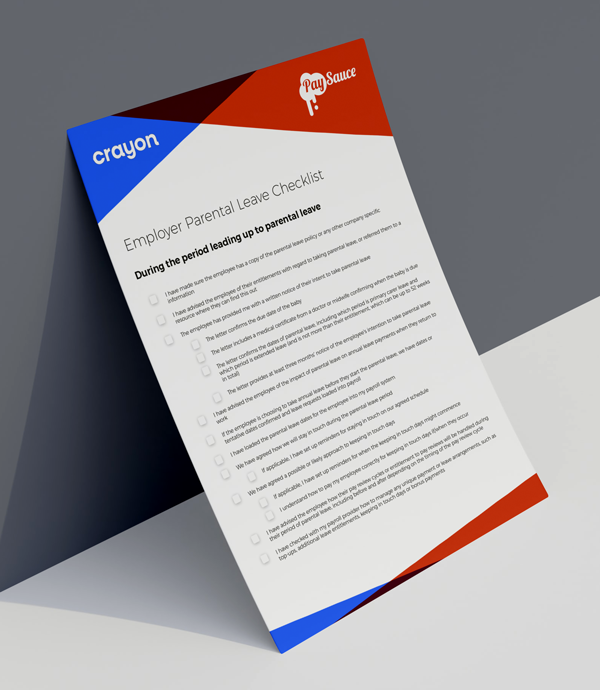Parental Leave
During Parental Leave
This is a guest collaboration series with our friend Stephanie Pow from Crayon - she's building the first home for money and parenthood in New Zealand, helping parents navigate the unique financial puzzles they face so they can be the parents they want to be.
You’re probably thinking, “This is going to cost me a lot of money.” Yes, financial support is valuable for expecting parents. But there are also many actions you can take to make your employee feel valued and not break the budget - they just require thoughtfulness and preparation.
Our goal here is to provide a comprehensive list of ways you can support employees going on parental leave. We recognise that what is financially feasible for an employer to offer depends on the size of the organisation and the industry they operate in. But we also believe every organisation in New Zealand can find at least one initiative here - and hopefully more - that works for them culturally and financially.
Additional paid leave
Employers can offer additional paid leave to the primary carer and/or the partner. Decisions you’ll need to make as an organisation:
Will your policy be gender-neutral or will you have different entitlements for the primary carer and the partner?
How many weeks and what percentage of wages will you pay?
Will the payment be a top-up (i.e. the organisation pays the difference between the government paid parental leave and the employee’s normal wages?) or will it be the full normal wage regardless of what the employee receives from the government?
(An employee who is paid top-ups while they are receiving parental leave payments will need to nominate one income stream to be taxed at a secondary rate.)
Will the payments be made in line with regular pay cycles, as a lump sum, in installments or some other timing? Will any of it be held back until the employee has returned to work?
What conditions will you impose? This can include eligibility requirements, clawbacks and terms for how the leave can be used.
KiwiSaver
An employee does not receive employer contributions to KiwiSaver while on parental leave, however from 1 July 2024, there is a government provided 3% contribution to employees who keep contributing to KiwiSaver while on parental leave. The default is that KiwiSaver is not deducted from Government paid parental leave, although the employee can elect to have KiwiSaver deducted from their paid parental leave when completing their application form (IR880).
Employers can contribute funds to their employee's KiwiSaver while they are still on parental leave, and this might be a great option if the employee is not still contributing and therefore not receiving the government contribution.
In the event of miscarriage, stillbirth or loss of child
Employers can choose to offer additional support if an employee faces this unfortunate situation. This typically comes in the form of additional paid leave on top of the government standard. Consider what your support could or would look like, and if you can commit to it, document it ahead of time. It is invaluable for employees to know how their employers have their back without being put in the position of asking.
Continued access
It’s only when you fully step back from work that you realise just how integrated work can be in your life. For example, your employee might be using a work mobile phone and simply not have their own to use. Or they might have limited access to other equipment like laptops or PCs. Employers can offer for employees continued access to systems and equipment on parental leave (assuming that’s what the employee wants) as well as services such as EAP (Employee Assistance Programme) and health insurance.
Pay reviews
It’s becoming common practice for employers to explicitly state in parental leave policies that employees on parental leave are included in standard pay review cycles. As we mentioned in Part 1, cost-of-living and performance-based adjustments can still be warranted for employees on parental leave. If you have an employee share scheme, you can ensure that the employee remains eligible to participate or that their vesting period will not be affected.
Additional Keeping In Touch (KIT) hours
There are strict rules around how KIT hours are used while the employee is receiving the 26 weeks of Government paid parental leave (see Part 2). However, once that period finishes, there are no restrictions on how much an employee can work. Some employers choose to offer additional KIT hours to help employees keep up to date before they officially return to work.
Other benefits
This is your chance to get creative! We’ve been pleasantly surprised by the breadth of benefits available nowadays, ranging from meal plans to subsidised access to baby services (such as a sleep consultant or lactation consultant) to gift vouchers for pamper services. For inspiration, we suggest you ask employees who have recently taken parental leave what would have been meaningful to them. You might find a big difference between those expecting their first child and those expecting their second, third or fourth! For example, at PaySauce for a recent arrival it was (mutually) agreed that meal delivery service vouchers were going to be the best option, but for someone else they might appreciate something totally different.
 Stephanie Pow
Founder & CEO - Crayon
Stephanie Pow
Founder & CEO - Crayon
 Jessica McLean
CPO - PaySauce
Jessica McLean
CPO - PaySauce


